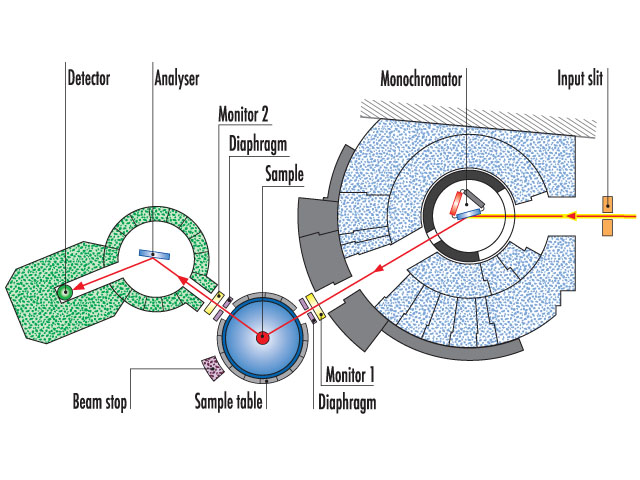IN8
Thermal neutron three-axis spectrometer
IN8 - Thermal neutron three-axis spectrometer
IN8 is a high-flux three-axis thermal neutron spectrometer designed to measure inelastic neutron scattering on single crystals in a wide energy and momentum transfer range. It is the highest thermal flux spectrometer worldwide with the monochromatic flux at the sample up to 109 neutrons/cm2/s where users can perform demanding experiments not possible anywhere else. In recent years, the IN8 spectrometer has undergone several major upgrades that have further extended the capabilities of the instrument to the limits achievable with the standard setup. The first part of the upgrade was centred on the replacement of the monochromator assembly, now consisting of four double focusing reflecting crystal faces with enhanced luminosity. The ensuing upgrade was to replace the entire secondary spectrometer. As the result, the new spectrometer, called Thermes, profits from a compact design and it is well shielded against ambient experimental background. All the incorporated modifications have given the instrument an unprecedented and unique luminosity combined with an improved signal-to-noise level and a remarkable configuration flexibility for a broad range of experimental requirements.
Applications
IN8 is optimised for inelastic measurements with an energy transfer in the range from a few meV to about one hundred meV and is used to investigate:
- diverse magnetic excitations and lattice vibrations in single crystals, atomic dynamics in liquids and molecular vibrations in complex polycrystalline solids
- samples of small volume and weak response due to its high incident flux
Instrument layout
A new monochromator assembly (Fig. 3) was commissioned in 2016, making use of experience in the engineering of multi-crystal arrays with remotely controlled two-dimensional (horizontal and vertical) variable focusing accumulated over the last decades.
The new device includes four crystal faces that can be alternatively set in Bragg reflection: mosaic pyrolytic graphite and copper crystals with reflecting planes PG002 and Cu200, as well as elastically bent perfect silicon crystals with reflecting planes Si111 and Si311 both eliminating the second order diffraction harmonics.
A new single-detector secondary spectrometer called ThermES (as abbreviated from Thermal Excitation Spectra) was commissioned in 2020 (Fig. 4).
Thermes has a compact design and optimized neutron shielding conceived to minimise all parasitic background not coming from the sample or passing away from the principal optical path. While the most of background in an IN8 experiment is typically stemming from the sample and its nearest environment (cryostat etc.), the signal-to-noise ratio could be anyway improved due to thoroughly arranged neutron shielding environment. An additional gain in high-resolution work is brought in by the new enriched boron coated slit collimators and thorough design of their neutron shielding that permitted eliminate major sources of background leaking into the zone around the analyser crystals.
The analysers in use are presented by the double-focussing devices built from mosaic crystals of pyrolytic graphite (reflection plane PG002) and copper (reflection plane Cu200) and also elastically bent perfect silicon crystals (reflection plane Si111).
The classical single-detector configuration of Thermes is enriched with a diaphragm positioned next to the Helium-3 counter. This diaphragm permits variation of the sensitive area of the neutron counter and helps to optimise the signal-to-noise ratio in the experiments with diverse sample sizes.
The new spectrometer proposes a larger dynamical range with respect to the previous setup, especially towards high values of momentum transfer or high scattering angles, now possible up to at least 120 degrees in both scattering directions.
Due to its modular structure the Thermes secondary spectrometer can be replaced, similarly to the previous setup, with the FlatCone multi-analyser spectrometer in case if mapping of the scattering intensity in different crystal planes is required.

